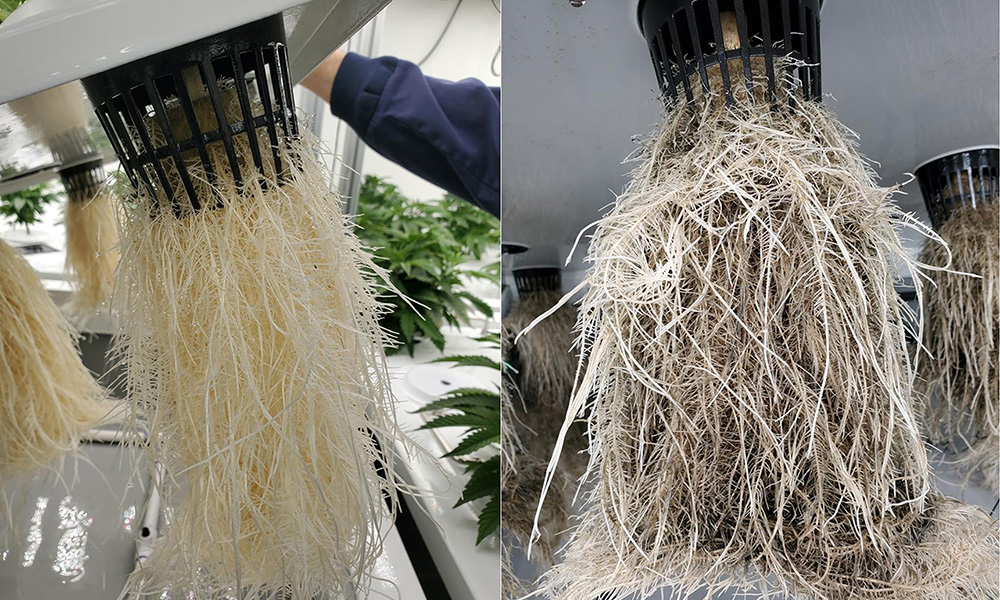
UBCO researchers isolated the genome for black root rot, a fungus killing cannabis plants in a licensed growing facility in the BC Kootenays. Here, healthy roots, left, are compared to those affected by black root rot.
A slippery black ooze, millions worth of cannabis plants and a ticking clock all contributed to one UBC Okanagan research team cracking the code of a potentially deadly fungus threatening the industry.
New research from UBCO doctoral student Chris Dumigan indicates his team has identified and analyzed Berkeleyomyces rouxiae--more commonly known as black root rot--in a crop affecting a Canadian licensed producer in the Kootenays.
A former classmate at the University of Guelph, Delaney Bray-Stone, emailed Dumigan for help. Bray-Stone, who would become a co-author of the research paper, needed help identifying a root-rot pathogen rapidly spreading through an aeroponic facility.
"He contacted me and sent me some pictures of root rot. They tested it for every available cannabis pathogen, and everything was fine. But if you look at the pictures of the initial infection, they were not fine," Dumigan said.
"They had to wipe out a crop because it was killing all the plants, but they also had to shut down a wing of their facility and throw out a whole bunch of equipment. All the filters would form this thick, black sludge. Delaney still has nightmares about this thing because of how much stress it caused him."
Dumigan's first challenge was reproducing black root rot in a lab to study, but conventional growing media didn't work. He was able to find an alternative, carrot agar.
"I think this is why it's been missed in the industry because it's difficult to culture; it's pretty specific," Dumigan said. "It almost needs fresh plant tissue that you convert into a media. But after I made this carrot agar, I returned the next day, and this black cell mass was growing on it that matched what I saw under a microscope."
The carrot agar allowed him to begin researching treatments. Commercial cannabis is unique because Canadian authorities tightly control conventional fungicides, so growers don't have exhaustive options.
"They're using things like sulphur to control fungi or canola oil for insects. Some biological products were approved, but many were developed for other crops," Dumigan said.
However, his thesis identifies several species of bacteria that inhabit roots and secrete compounds that can kill certain fungi.
"I've found several of them that kill this fungus, but none of this is published. It's only a potential biocontrol, but they could be registered in Canada because it's a certified organic option, not a conventional fungicide," Dumigan said.
That's the next phase. Dumigan, who worked with thesis adviser Dr. Michael Deyholos in the Irving K. Barber Faculty of Science at UBCO, released the genome for other researchers to download and study. He's also working on a sequence-based diagnostic test so labs can help other producers worldwide avoid the same issues.
"This is science. To do something new, to discover something new, I don't have an economic incentive in the cannabis industry. But I have a personal interest in pushing the boundaries of science."
The research appears in the journal Plant Disease.
The post UBCO researcher shines a light on "nightmare" ooze killing cannabis plants appeared first on UBC Okanagan News.
 Woman jailed for sex assault
Woman jailed for sex assault Rescued after fall into river
Rescued after fall into river Killer not happy with show
Killer not happy with show Facial recognition at border?
Facial recognition at border? PM ups attacks on Poilievre
PM ups attacks on Poilievre CRA will get the money: PM
CRA will get the money: PM Instagram fraudster jailed
Instagram fraudster jailed 11 Trump allies indicted
11 Trump allies indicted Ukraine uses new missiles
Ukraine uses new missiles BoC officials split on rate cut
BoC officials split on rate cut Big loss for Boeing
Big loss for Boeing  Metro sales edged higher
Metro sales edged higher Vees dominating Vipers
Vees dominating Vipers Warriors snakebitten in loss
Warriors snakebitten in loss Iginla off to Europe
Iginla off to Europe Coachella fined $28K
Coachella fined $28K Those are her nipples
Those are her nipples Kanye to launch porn studio
Kanye to launch porn studio




